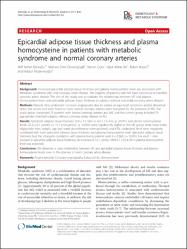| dc.contributor.author | Balcıoğlu, Akif Serhat | |
| dc.contributor.author | Durakoğlugil, Murtaza Emre | |
| dc.contributor.author | Çiçek, Davran | |
| dc.contributor.author | Bal, Uğur Abbas | |
| dc.contributor.author | Boyacı, Bülent | |
| dc.contributor.author | Müderrisoğlu, Haldun | |
| dc.date.accessioned | 2020-12-19T20:03:13Z | |
| dc.date.available | 2020-12-19T20:03:13Z | |
| dc.date.issued | 2014 | |
| dc.identifier.citation | Balcioglu, A.S., Durakoglugil, M.E., Cicek, D., Bal, U.A:, Boyaci, B., Muderrisoglu, H., (2014).Epicardial adipose tissue thickness and plasma homocysteine in patients with metabolic syndrome and normal coronary arteries.Diabetology & Metabolic Syndrome, 6, Article number 62.https://doi.org/10.1186/1758-5996-6-62 | |
| dc.identifier.issn | 1758-5996 | |
| dc.identifier.uri | https://doi.org/10.1186/1758-5996-6-62 | |
| dc.identifier.uri | https://hdl.handle.net/11436/3120 | |
| dc.description | Durakoglugil, Emre/0000-0001-5268-4262; Muderrisoglu, Haldun/0000-0002-9635-6313 | en_US |
| dc.description | WOS: 000336622800001 | en_US |
| dc.description | PubMed: 24872849 | en_US |
| dc.description.abstract | Background: Increased epicardial adipose tissue thickness and plasma homocysteine levels are associated with Metabolic Syndrome (MS) and coronary artery disease. the majority of patients with MS have subclinical or manifest coronary artery disease. the aim of this study was to evaluate the relationship between MS and plasma homocysteine levels and epicardial adipose tissue thickness in subjects without epicardial coronary artery disease. Methods: Patients who underwent coronary angiography due to angina or equivocal symptoms and/or abnormal stress test results and were found to have normal coronary arteries were evaluated for the presence of MS. the study group comprised 75 patients with normal coronary arteries and MS, and the control group included 75 age-gender matched subjects without coronary artery disease or MS. Results: Epicardial adipose tissue thickness (5.8 +/- 1.9 mm vs. 4.3 +/- 1.6 mm, p <0.001) and plasma homocysteine levels (21.6 +/- 6.1 mu mol/L vs. 15.1 +/- 5.8 mu mol/L, p <0.001) were significantly higher in the MS group. Body mass index, triglyceride level, weight, age and waist circumference were positively and HDL cholesterol level were negatively correlated with both epicardial adipose tissue thickness and plasma homocysteine level. Epicardial adipose tissue thickness had the strongest correlation with plasma homocysteine level (r = 0.584, p < 0.001). For each 1 mm increase in epicardial adipose tissue thickness, an increase of 3.51 mu mol/L (95% CI: 2.24-4.79) in plasma homocysteine level was expected. Conclusions: We observed a close relationship between MS and epicardial adipose tissue thickness and plasma homocysteine levels, even in the absence of overt coronary artery disease. | en_US |
| dc.language.iso | eng | en_US |
| dc.publisher | Bmc | en_US |
| dc.rights | info:eu-repo/semantics/openAccess | en_US |
| dc.subject | Angina pectoris | en_US |
| dc.subject | Coronary angiography | en_US |
| dc.subject | Epicardial fat | en_US |
| dc.subject | Homocysteine | en_US |
| dc.title | Epicardial adipose tissue thickness and plasma homocysteine in patients with metabolic syndrome and normal coronary arteries | en_US |
| dc.type | article | en_US |
| dc.contributor.department | RTEÜ, Tıp Fakültesi, Dahili Tıp Bilimleri Bölümü | en_US |
| dc.contributor.institutionauthor | Durakoğlugil, Murtaza Emre | |
| dc.identifier.doi | 10.1186/1758-5996-6-62 | |
| dc.identifier.volume | 6 | en_US |
| dc.ri.edit | oa | en_US |
| dc.relation.journal | Diabetology & Metabolic Syndrome | en_US |
| dc.relation.publicationcategory | Makale - Uluslararası Hakemli Dergi - Kurum Öğretim Elemanı | en_US |


















